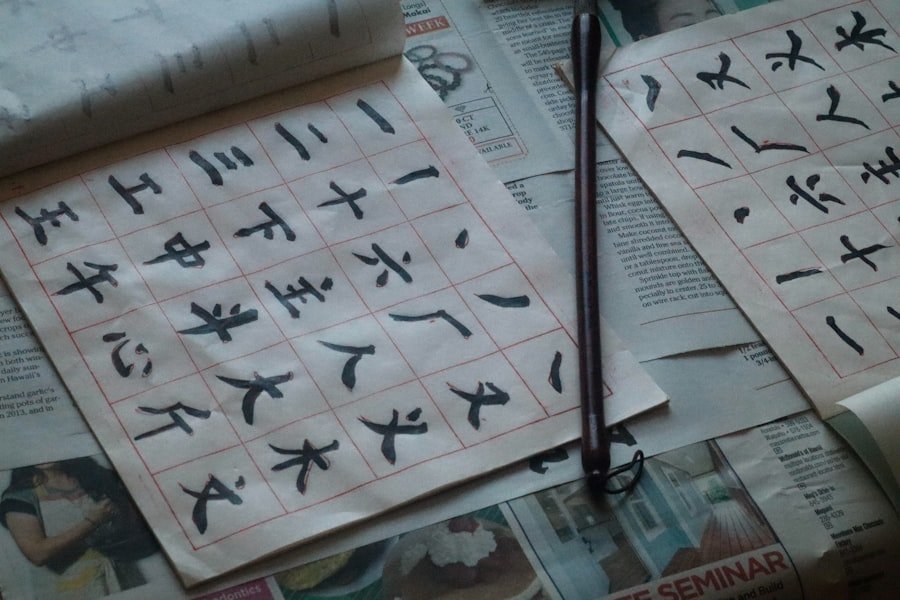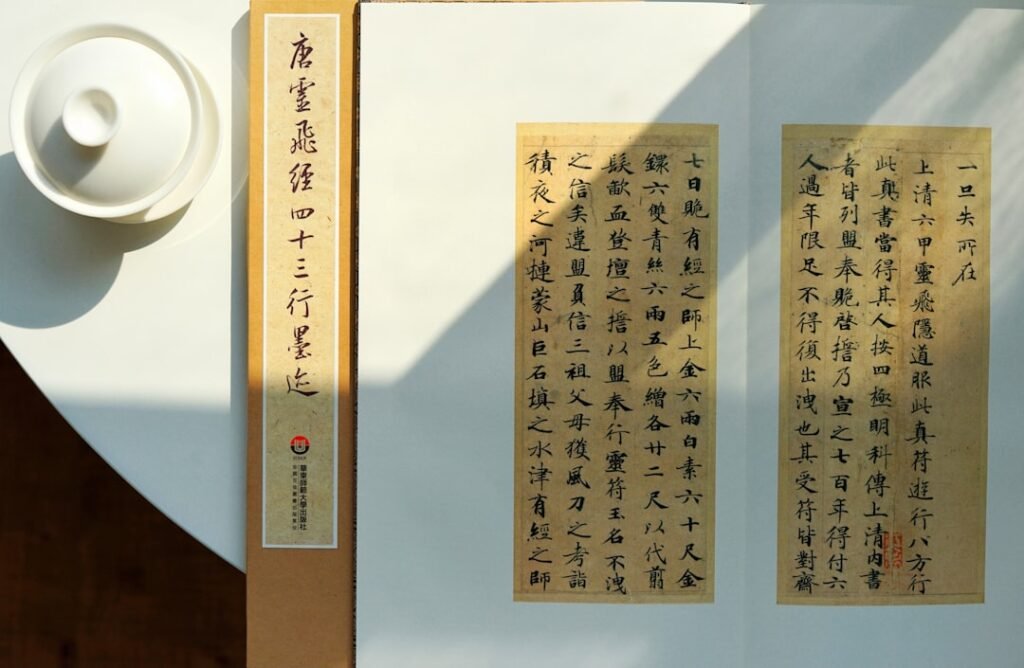Spirit resonance, or “Shen Yun,” is a profound concept in Chinese calligraphy that transcends mere technique and aesthetics. It embodies the essence of the artist’s spirit, emotions, and intentions, manifesting in the strokes of the brush. This resonance is not merely about the physical act of writing; it is an expression of the artist’s inner world, a dialogue between the self and the universe.
When a calligrapher achieves spirit resonance, their work becomes a living entity, pulsating with energy and vitality, inviting viewers to engage with it on a deeper level. The concept of spirit resonance is deeply rooted in the philosophy of Chinese art, where the act of creation is seen as a spiritual journey. It is believed that when an artist is in harmony with their surroundings and their own emotions, their brushwork reflects this balance.
The strokes become imbued with life, conveying not just words but feelings and thoughts that resonate with the observer. This connection between the artist’s spirit and the viewer’s perception creates a shared experience that elevates calligraphy from a simple craft to a profound art form. Master the art of Chinese calligraphy. Enroll now at the LC Chinese School in Oslo.
Table of Contents
ToggleSummary
- Spirit resonance in Chinese calligraphy refers to the energy and vitality infused into the artwork by the artist.
- Spirit resonance has been a significant aspect of Chinese art for centuries, reflecting the artist’s connection to the spiritual and philosophical dimensions of their work.
- The relationship between spirit resonance and qi in calligraphy emphasises the importance of energy flow and vitality in creating art that resonates with the viewer.
- Techniques for achieving spirit resonance in Chinese calligraphy include controlling brush strokes, ink density, and the use of space to convey emotion and intention.
- Intention and emotion play a crucial role in creating spirit resonance, as the artist’s state of mind and emotions are reflected in the artwork.
The Historical Significance of Spirit Resonance in Chinese Art
Historically, spirit resonance has played a pivotal role in the evolution of Chinese art, particularly in calligraphy. Ancient scholars and artists viewed calligraphy as a reflection of one’s character and moral integrity. The ability to convey spirit resonance was seen as a mark of mastery, indicating that the artist had not only honed their technical skills but had also cultivated their inner self.
This belief was prevalent during the Tang and Song dynasties, periods renowned for their artistic achievements and philosophical advancements. The significance of spirit resonance can also be traced back to classical texts, such as the “Treatise on Calligraphy” by Wang Xizhi, who is often regarded as the Sage of Calligraphy. In his writings, he emphasised the importance of cultivating one’s character and emotions to achieve true artistic expression.
This historical perspective underscores the idea that calligraphy is not merely an aesthetic pursuit but a means of personal and spiritual development. As such, spirit resonance has become an enduring principle that continues to influence contemporary practices in Chinese art.
The Relationship Between Spirit Resonance and Qi in Calligraphy

In Chinese philosophy, Qi (or “Chi”) refers to the vital life force that flows through all living beings. In the context of calligraphy, there exists a profound relationship between spirit resonance and Qi. When an artist engages with their brush, they channel their Qi into their strokes, allowing their energy to flow onto the paper.
This connection between spirit and Qi is essential for achieving a sense of harmony and balance in one’s work. The interplay between spirit resonance and Qi can be observed in the fluidity and dynamism of brush strokes. A calligrapher who is attuned to their Qi can create strokes that are not only visually striking but also imbued with emotional depth.
The energy behind each stroke resonates with the viewer, creating an experience that transcends mere visual appreciation. Thus, understanding and harnessing Qi is fundamental for any calligrapher seeking to achieve spirit resonance in their work.
Techniques for Achieving Spirit Resonance in Chinese Calligraphy
Achieving spirit resonance in Chinese calligraphy requires a combination of technical skill and emotional awareness. One essential technique is to cultivate a deep connection with one’s brush and ink. This involves not only mastering the physical aspects of calligraphy but also developing an intuitive understanding of how to express one’s emotions through brushwork.
Practising regularly while maintaining a mindful approach can help artists tap into their inner selves, allowing their spirit to resonate through their strokes. Another important technique is to embrace spontaneity in one’s practice. While discipline and precision are crucial in calligraphy, allowing for moments of improvisation can lead to unexpected expressions of spirit resonance.
This spontaneity encourages artists to let go of rigid expectations and instead focus on the flow of energy within themselves. By embracing both structure and freedom, calligraphers can create works that are rich in emotional depth and resonate with viewers on multiple levels.
The Role of Intention and Emotion in Creating Spirit Resonance
Intention and emotion are central to the creation of spirit resonance in calligraphy. An artist’s intention serves as a guiding force, shaping the direction and energy of each stroke. When an artist approaches their work with clarity of purpose—whether it be to convey joy, sorrow, or contemplation—the resulting calligraphy reflects this emotional landscape.
The viewer can sense this intention, creating a connection that transcends words. Moreover, emotions play a vital role in infusing calligraphy with life. A calligrapher who allows their feelings to flow through their brushwork can create pieces that resonate deeply with others.
For instance, a stroke imbued with joy may appear light and airy, while one expressing melancholy may carry a heavier weight. By embracing their emotions and allowing them to guide their practice, artists can achieve a level of spirit resonance that captivates viewers and invites them into an intimate dialogue with the artwork.
The Importance of Breath and Movement in Chinese Calligraphy

Breath and movement are fundamental elements in achieving spirit resonance in Chinese calligraphy. The act of breathing serves as a bridge between the artist’s inner world and their external expression. By synchronising breath with brush movements, calligraphers can cultivate a sense of flow and rhythm in their work.
This connection allows for greater control over the brush while also enabling the artist to channel their Qi more effectively. Movement is equally significant; it encompasses not only the physical act of writing but also the mental state of the artist. A relaxed yet focused posture can enhance fluidity in strokes, while tension can hinder expression.
Practising mindful movement—where each stroke is executed with intention—can lead to a more profound sense of spirit resonance. As artists learn to harmonise their breath and movement, they unlock new dimensions within their calligraphy, creating works that resonate deeply with both themselves and their audience.
Examining the Spiritual and Philosophical Dimensions of Spirit Resonance
The spiritual and philosophical dimensions of spirit resonance are deeply intertwined with traditional Chinese beliefs about art and existence. In many ways, calligraphy serves as a microcosm of life itself—a reflection of one’s journey towards self-discovery and enlightenment. The pursuit of spirit resonance encourages artists to explore not only their technical abilities but also their understanding of existence, consciousness, and connection to the universe.
Philosophically, spirit resonance aligns with concepts such as Daoism and Confucianism, which emphasise harmony between humanity and nature. Calligraphers who embody these principles often find that their work becomes an extension of their spiritual practice—a means through which they can express their understanding of life’s complexities. By delving into these philosophical dimensions, artists can enrich their practice, allowing spirit resonance to emerge as a natural outcome of their exploration.
Exploring the Symbolism and Meaning Behind Spirit Resonance in Calligraphy
Spirit resonance carries rich symbolism within the realm of Chinese calligraphy. Each stroke represents not only letters or characters but also emotions, intentions, and cultural narratives. The ability to achieve spirit resonance transforms these symbols into vessels for deeper meaning—inviting viewers to engage with them on multiple levels.
For instance, a character written with fluidity may evoke feelings of gracefulness or freedom, while one executed with boldness may convey strength or determination. Moreover, spirit resonance serves as a reminder of the interconnectedness between artist and observer. When an artist successfully conveys their inner world through their work, they create an opportunity for viewers to reflect on their own experiences and emotions.
This exchange fosters a sense of unity—an understanding that art transcends individual expression to become part of a collective human experience.
The Impact of Spirit Resonance on the Viewer and the Artist
The impact of spirit resonance extends beyond the artist’s experience; it profoundly influences how viewers engage with calligraphic works. When an artwork resonates with its audience, it evokes emotional responses that can range from joy to contemplation or even nostalgia. This connection creates an immersive experience where viewers feel drawn into the narrative woven by the artist’s strokes.
For artists themselves, achieving spirit resonance can be transformative. It fosters a sense of fulfilment and purpose as they witness their work resonate with others. This feedback loop encourages continuous exploration and growth within their practice—pushing them to delve deeper into their emotions and intentions.
Ultimately, both artist and viewer become participants in a shared journey through art—a testament to the power of spirit resonance in bridging individual experiences.
Incorporating Spirit Resonance into Modern Chinese Calligraphy Practices
Incorporating spirit resonance into modern Chinese calligraphy practices involves blending traditional techniques with contemporary expressions. As artists navigate an ever-evolving cultural landscape, they have the opportunity to reinterpret age-old principles while remaining true to the essence of spirit resonance. This fusion allows for innovative approaches that honour tradition while embracing new ideas.
Modern practitioners often experiment with various materials, styles, and themes—infusing their work with personal narratives that reflect contemporary society. By doing so, they create spaces for dialogue around identity, culture, and emotion—inviting viewers to engage with calligraphy in fresh ways. As artists continue to explore these intersections between tradition and modernity, spirit resonance remains a guiding principle that enriches both their practice and its impact on audiences.
Embracing the Beauty and Power of Spirit Resonance in Your Own Calligraphy Art
For those interested in exploring spirit resonance within their own calligraphy art, courses such as those offered at LC Chinese School in Oslo provide an excellent foundation for developing both technical skills and emotional awareness. These courses emphasise not only mastering brush techniques but also understanding how intention, emotion, breath, and movement contribute to achieving spirit resonance. At LC Chinese School, students are encouraged to delve into the philosophical dimensions behind calligraphy while cultivating their unique artistic voices.
With experienced instructors guiding them through various exercises designed to enhance both skill and emotional expression, participants can discover how to infuse their work with life and energy. By embracing this holistic approach to learning calligraphy at LC Chinese School, aspiring artists can unlock new dimensions within themselves—allowing them to create works that resonate deeply with both themselves and others. In conclusion, understanding spirit resonance is essential for anyone seeking to explore the depths of Chinese calligraphy.
By engaging with this concept through practice, reflection, and education—such as those offered at LC Chinese School—artists can cultivate a profound connection between themselves and their art form. Ultimately, embracing spirit resonance allows individuals not only to express themselves more fully but also to connect meaningfully with others through the beauty of calligraphy.
Master the art of Chinese calligraphy. Enroll now at the LC Chinese School in Oslo.







